Did you know many cool things from the 1950s still make our lives awesome today? But first, let’s remember the neat stuff from the 1940s and earlier that set the stage for what came next.
The 1940s were transformative, with innovations like the atomic bomb reshaping global politics. Alongside it came practical inventions like the versatile Jeep, the enduring Slinky toy, and the revolutionary point-contact transistor, laying the groundwork for modern electronics.
Other inventions like aerosol spray cans, kidney dialysis machines, and microwave ovens introduced new possibilities. Plus, groundbreaking technologies like the Aqua-Lung and ENIAC emerged, shaping societal norms and behaviors.
The 1950s were exciting, with terrific gadgets and inventions like foam rubber that changed everything. And remember, back then, computers were starting to become a thing, laying the groundwork for the ones we use daily.
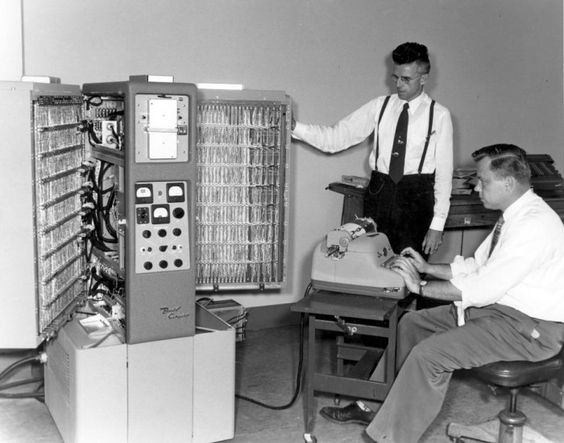
Credits: @wordpressdotcom / Pinterest
Key Takeaway
- The 1940s and 1950s were important times for new inventions and progress, like the atomic bomb and the Jeep, which paved the way for today’s technology.
- After World War II, things got better with more education and money for people, thanks to programs like the GI Bill, which helped veterans go to college and buy homes.
- In the 1950s, science became a big deal. We got color TV, the first computers, and even started going into space.
- Smart people in the 1950s, like John Bardeen and Jack Kilby, made cool things like transistors and microchips, which are the reason our computers and gadgets are so small and powerful today.
The Technology Boom and Modern Revolution
As I delve into the realm of 1950s technology, I am amazed at its pivotal role in shaping the world we live in today.
Post-World War II, the world witnessed an unprecedented surge in technological advancement, laying the foundation for the modern revolution.
Let’s check through the innovations of the 1950s that changed our lives forever.
Post-WWII Improvements in Economy and Education
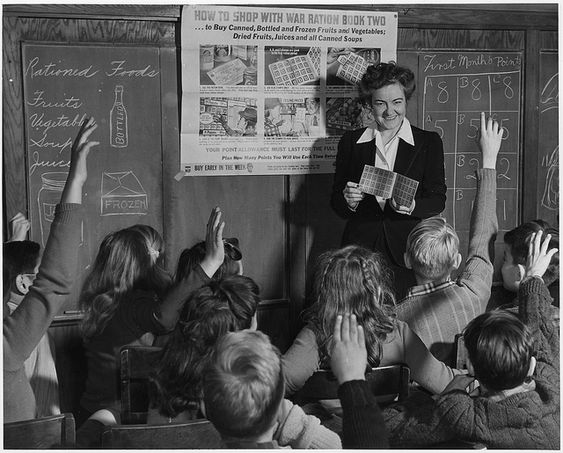
Credits: @scanmyphotos /Pinterest
The post-World War II era witnessed remarkable economic and educational transformations. Implementing the GI Bill in 1944 provided over 8 million veterans with access to education, spurring a surge in college attendance and homeownership.
This and government-backed home loans fueled an economic boom, transitioning factories from wartime production to consumer goods manufacturing. Gross private investment and actual consumption soared, reflecting a newfound prosperity.
In education, reforms led to a structured administration and curriculum overhaul, focusing on disciplines tailored to the changing security and economic landscape.
High school and university enrollment surged, reflecting a growing emphasis on education as a driver of economic advancement.
Overall, the post-World War II period laid the groundwork for significant progress and growth, shaping the trajectory of technological advancements and societal change for years to come.
New Focus on Scientific Advancement
The 1950s marked a shift towards a new focus on scientific advancement. Governments and industries recognize the potential of technology to drive progress and improve lives. Some of these are as follows:
- Color television became a household staple, revolutionizing entertainment with vivid visuals.
- The introduction of the UNIVAC I, the first commercially produced computer, heralded a new era of computing.
- Jet aircraft transformed travel, enabling nonstop flights across continents.
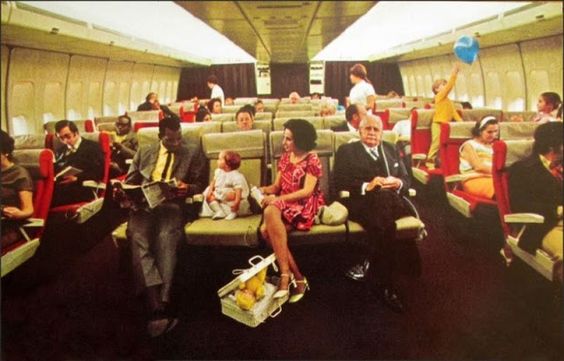
Credits: @vintageeveryday / Pinterest
- The launch of Sputnik in 1957 marked the dawn of the space age, propelling humanity into a new era of exploration.
- The development of the hydrogen bomb fueled tensions in the nuclear arms race.
- Innovations in the music industry, such as LPs and “45s,” revolutionized how music was enjoyed and distributed.
These inventions reshaped American culture and spurred global technological progress, ushering in societal transformations that resonate today.
Overview and Statistics on Surge in US Patents
During the 1950s, the United States experienced an explosion in patent filings, reflecting the unprecedented pace of innovation.
From breakthroughs in materials like plastics and foam rubber to the development of modern computers, inventors pushed the boundaries of what was possible. These patents not only transformed industries but also profoundly impacted our daily lives.
Thus, it laid the groundwork for the digital age we live in today.
Pioneers of Change: Key Innovators of the 1950s Technology
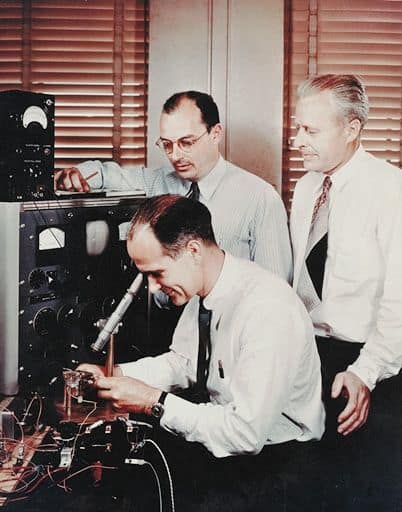
Credits: @attinc / Pinterest
In the bustling decade of the 1950s, visionaries emerged, shaping the foundation of modern technology. Among them was John Bardeen, a pioneer in electronics.
His co-invention of transistors revolutionized communication, paving the way for the emergence of modern computing.
Bardeen’s work set a precedent, illustrating the power of collaboration and perseverance in technological advancement. Some of these are the following, together with the inventors:
- Harold Hopkins and Narinder Singh Kapany: They introduced optical fiber in 1956, transforming communication technology with its rapid data transmission abilities.
- Gerald Pearson: In 1954, Pearson unveiled the first practical silicon solar cell, laying the groundwork for the application of solar energy.
- Jack Kilby and Robert Noyce: These pioneers developed the inaugural microchip in 1958, a milestone that revolutionized computing and set the stage for modern electronics.
- Joseph Woodland and Bernard Silver: Their barcode creation in 1952 revolutionized product identification and inventory management.
- Christopher Cockerell: In the 1950s, Cockerell introduced the hovercraft, offering a unique mode of transportation gliding on a cushion of air.
- Sherman and Smith: Collaboratively launched Scotchgard™ Protector in the 1950s, transforming fabric stain protection.
- Bette Nesmith Graham: Graham invented “Mistake Out,” later known as Liquid Paper, providing a solution for correcting typing errors.
- George de Mestral: Mestral patented Velcro in the 1950s, offering a versatile fastening system inspired by burdock burrs.
These innovators played pivotal roles in advancing technology during the 1950s, which we may have seen from influential TV programs. Their inventions continue to influence our lives today.
Information and Computing Technologies for Modern Computers
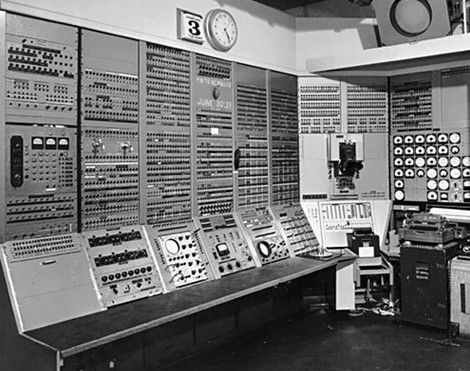
Credits: @computerhope / Pinterest
As mentioned, one of the most significant advancements during this time was the introduction of transistors and integrated circuits.
Imagine this: before transistors, electronic devices relied on bulky vacuum tubes, making them large, expensive, and inefficient. But then, in the 1950s, scientists and engineers invented transistors, tiny semiconductor devices that could amplify and switch electronic signals.
This innovation revolutionized the world of electronics, paving the way for smaller, more reliable, and affordable devices.
Alongside transistors, integrated circuits were also developed in the 1950s. These circuits combined multiple electronic components onto a single semiconductor chip, making electronics even smaller and more powerful.
The journey from bulky vacuum tubes to these miniature circuits was remarkable.
Patents and a timeline of microchip development serve as a testament to the rapid progress made during this era.
In 1959, Jack Kilby of Texas Instruments created the first integrated circuit, while Robert Noyce of Fairchild Semiconductor independently developed a similar technology. Their inventions created the groundwork for the microelectronics industry that followed.
The impact of microelectronics on computing cannot be overstated. With the invention of smaller and more powerful components, computers evolved from room-sized machines to desktops.
Eventually, they evolved into the sleek laptops and smartphones we use today. Thus, the 1950s technology was a turning point in history, setting the stage for a digital revolution.
Invention and Proliferation of Formable Materials
Another significant tech advancement during this time was the formable materials.
Origins of Newly Created Plastics/Foam Rubber
These emerged as newly created materials in the 1950s, transforming how we manufacture products.
Before this era, traditional materials like wood, metal, and natural fibers dominated manufacturing processes. However, developing synthetic polymers such as polyethylene and polypropylene revolutionized the industry.
These materials offered unparalleled versatility, durability, and affordability, making them immensely popular among manufacturers.
Engineers and Chemists Responsible for Materials Advances
Behind these groundbreaking inventions were brilliant engineers and chemists who tirelessly worked to unlock the potential of synthetic materials.
Visionaries like Leo Baekeland, the inventor of Bakelite, and Wallace Carothers, the mind behind nylon, paved the way for a new era of material science. Their relentless pursuit of innovation created materials that forever changed how we live.
Applications Across Industries Like Furniture and Clothing
The widespread adoption of plastics and foam rubber across various industries reshaped how products were designed, manufactured, and consumed. In the furniture industry, lightweight and durable plastics replaced traditional wood and metal.
This led to the creation of iconic designs like the Eames Chair. Similarly, foam rubber revolutionized the fashion industry, offering enhanced comfort and flexibility.
These innovations show how these material advancements transformed industries and impacted people’s everyday lives. From the furniture we sit on at home to the clothes we wear, the innovations of the 1950s continue to shape our modern world.
Technological Advancement in Communication Technology Leaps Forward
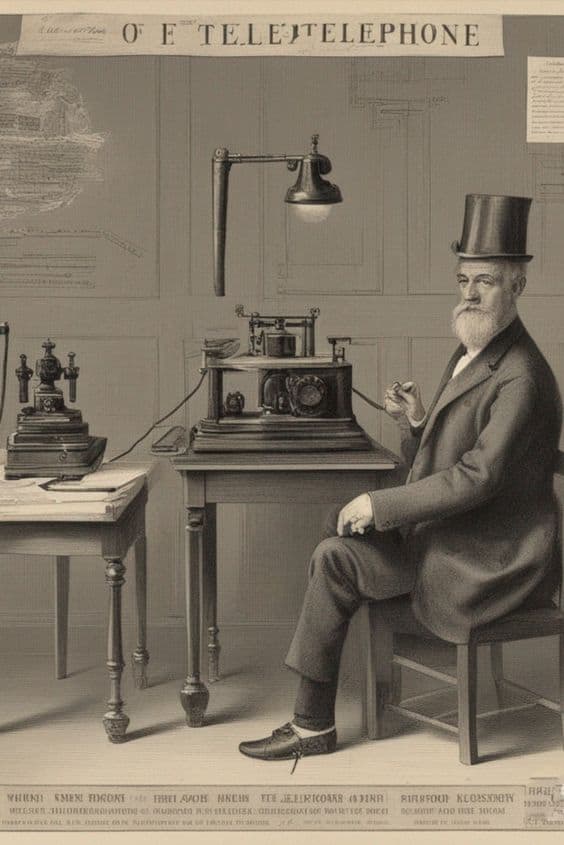
Credits: @yuvrajpatil87 / Pinterest
Back in the 1950s, communication took a giant leap forward. Television networks started popping up all over America, bringing the world into people’s living rooms. Can you imagine the excitement of seeing events unfold live on screen for the first time?
Not only that, but the 50s also saw the documentation of the very first coast-to-coast telephone call. It was a historic moment, connecting people from one end of the country to the other like never before. Suddenly, distance didn’t seem so daunting anymore.
And let’s remember the mobile radiophones that made communication even more portable. It was like having a phone booth in your pocket! Being able to communicate while on the move revolutionized the way people lived and worked.
These technological advancements in communication during the 1950s laid the groundwork for the interconnected world we live in today. From the humble beginnings of television networks to the convenience of mobile phones, the 50s made our reality worthwhile.
Automotive Advancements Change Transportation

Wheels, like Chrysler, weren’t just rolling in the ‘50s; they were revolutionizing! Concept cars were like glimpses into the future, showing us flying cars and sleek designs from sci-fi movies. But reality had its own plans.
Some of those wild ideas stayed on the drawing board, while others evolved into the cars we see on the roads today.
Now, let’s talk about cost. Back then, buying a car – like a Dodge or Ford – was a luxury for many. But thanks to innovations in manufacturing, like the assembly line, cars became more affordable. Speaking of affordability, if you want to know if young adults today can afford cars in the 1950s, read our blog!. They went from being a dream to a driveway staple practically overnight!
And who could forget about the hovercraft? Christopher Cockerell dreamed up this wild idea of gliding over both land and water. It was like something out of a futuristic comic book!
Sure, it took some time to perfect, but it laid the groundwork for modern amphibious vehicles.
Evolution of Lifestyles and Culture

Wondering about family life in the 1950s? Well, life was undergoing a significant transformation in this era, too. Suburban living was on the rise, with more families moving out of crowded cities into spacious houses in the suburbs.
Statistics show that the number of suburban households doubled during this time, thanks to advancements in transportation and the availability of affordable housing.
But it wasn’t just about where our folks lived but also about how they lived. People were buzzing with excitement about technology. A survey conducted during the era revealed that a whopping 70% of the population was enthusiastic about embracing new tech.
Everyone wanted a piece of the action, from sleek appliances to futuristic gadgets.
And let’s not forget the music scene! The 1950s saw a revolution in how we enjoyed music, thanks to portable transistor radios. Suddenly, we could carry our favorite tunes with us wherever we went.
It wasn’t just about listening; it was about experiencing music in a whole new way – anytime, anywhere.
In essence, the 1950s was a time of cultural revolution. It’s where every innovation brought us closer to the modern world we know today.
Conclusion: The Lasting Legacy in the Modern Day
As I reflect on how far we’ve come, it’s fascinating to see the lasting impact on our modern lives.
Integrated circuits? They’re the powerhouse behind our computers today, making them faster and more efficient than ever before. Can you imagine life without them? I sure can’t!
And let’s not forget about foam rubber and plastics. These materials are everywhere, from our comfy mattresses to the sleek gadgets we can’t live without. If you’re juggling projects and essays while marveling at modern conveniences, a college admission essay writing service can help lighten the load and keep you focused on your goals.
When it comes to safety, comparing 1950s cars to today’s standards is eye-opening. We’ve come a long way in protecting drivers and passengers alike.
If you’re hungry for more knowledge, you can find a lot of educational resources online to dive deeper into the world of 1950s tech. Or comment below what you want us to talk more about the 1950s technology.
The past may be behind us, but its impact on our present is undeniable.
